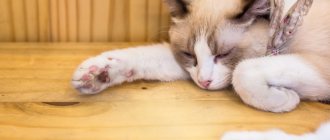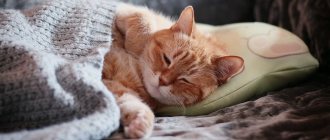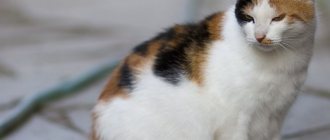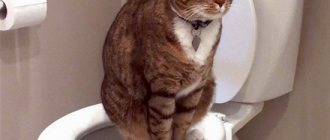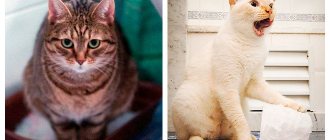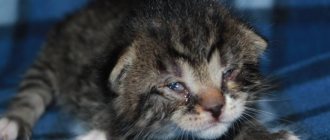When a pet is sick, the owner suffers along with it. Especially when it comes to situations where the cat vomits yellow liquid. At this moment, you want to do anything to ease the suffering of your pet.
First of all, you should remember that vomiting is a kind of protective reflex of the body. Through this process, it tries to get rid of all the organisms and harmful substances that are poisoning it. You also need to take into account that vomit can be of different types and compositions. A yellow liquid is also possible.
The only thing you need to remember in any of these situations is that you must immediately consult a doctor. It is he who will be able to conduct a full examination of the animal and determine the cause of the disease. True, you shouldn’t immediately run to the vet at the first urge to vomit. But if it does not stop for several days, or the spasms themselves are very frequent, then consultation with a specialist is needed as soon as possible.
Only a veterinarian will be able to conduct a full examination of the animal and determine the cause of the disease.
Of course, there are other recommendations that also need to be followed if these symptoms appear in an animal. If you do everything correctly, you can significantly alleviate the suffering of your pet.
The first step is to clarify the reasons for the manifestation of vomiting spasms in a cat. There are several main factors that cause this symptom:
- if a cat falls asleep without eating, then it is likely that in the morning she will vomit;
- vomiting may occur if the animal is overfed;
- eating low-quality food or other products.
If we talk about yellow discharge, then, first of all, this indicates that this liquid contains bile impurities. Accordingly, there is bile in the pet’s stomach itself. And this is already a sign of some disease. After all, a healthy animal should not have bile in its stomach.
Vomiting may occur if the animal is overfed
If this does happen, then you urgently need to check the condition of the animal’s duodenum and liver. You should also remember that vomiting yellow liquid can cause very strong irritation of the gastric mucosa, which can lead to the onset of a severe inflammatory process.
Therefore, when your cat vomits yellow liquid, you should immediately consult a doctor. He will prescribe special medications that will help stop the spasm, and thereby reduce the likelihood of further stomach irritation.
What does each discharge indicate when vomiting occurs?
If your pet has vomited a couple of times at most and is feeling quite normal, there is no need to panic. This can be caused by intestinal irritation, which occurs due to swallowing fur or a large clump of grass. In this case, it is recommended to monitor the pet’s condition for one day and then look for the reasons for the deterioration of its health.
The cat may vomit bile, as indicated by the yellow color, and may also suffer from other discharges. Regular vomiting of a rich yellow or green hue primarily indicates that there are problems in the functioning of the liver or kidneys. There may also be stomach problems.
Blood present in the vomit may indicate that the esophagus or pharynx has been damaged by some sharp object, such as a fish bone.
What causes yellow color
Yellow vomit indicates that there is bile in the cat’s stomach, which should not be there if the body is healthy. It quickly irritates the walls of the stomach, since it is an aggressive substance for the gastrointestinal tract. In this case, the vomit acquires a rich, bright yellow color and a specific smell.
Important! Sometimes the yellow color of vomit may be due to the presence of dyes in industrial feeds, but in this case the mass has a grayish-yellow rather than a rich yellow tint.
If your cat is vomiting yellow liquid, it is important to consider:
- time and conditions of the first vomiting;
- frequency of vomiting;
- amount and consistency of vomit;
- presence of appetite and desire to drink;
- last meal;
- the likelihood that the cat swallowed something inedible or spoiled;
- the appearance of other symptoms;
- chronic pet diseases;
- vaccination and deworming.
If you need to contact a veterinarian, this information will help you quickly understand the situation and make the correct diagnosis.
Causes of nausea and vomiting in cats
Burping fur is a physiological process of getting rid of external irritants and should not be a cause for concern. But if this happens regularly, you should contact a specialist who will determine the cause of this condition.
The main reasons why a pet may vomit:
- In Siamese cats, underdevelopment of the posterior wall of the stomach (pylorus) is common. Because of this, “fountain” vomiting occurs. In this case, only surgery helps.
- Pregnancy can also cause nausea and vomiting due to changes in the body and hormonal imbalance.
- Vomiting often accompanies ear diseases in cats.
- Disturbances in the liver (pancreatitis, lipidosis) or pathologies associated with the kidneys can cause yellow vomiting in the cat.
- Nausea is also accompanied by pathologies such as stomach or pancreatic cancer.
- Intestinal obstruction.
- Parasites that poison the pet’s body from the inside.
- Stress (moving, a long trip in transport can cause motion sickness in a cat and, accordingly, vomiting).
Possible causes based on the type of vomit
Lack of appetite in pets is common. Often
the health of cats is normalized and does not pose a threat. But there are situations when a minor deviation in a pet’s health develops into a serious pathology. There are several main causes of nausea.
Wool
In the process of washing themselves, cats constantly lick off fur from themselves, which accumulates in their stomach.
Such a lump is called a bezoar. This is a natural and harmless process. By periodically regurgitating hairballs, the pet gets rid of it on its own.
During periods of active molting, bezoars that are too large may form. This is especially true for fluffy long-haired breeds.
The animal cannot vomit such a lump on its own. The most dangerous consequences of this can be blockage of the digestive tract and intoxication of the body.
Poisoning and infections
In the process of washing, cats constantly lick off their fur, which accumulates in their stomach.
Many domestic cats go outside. There they can eat spoiled food or get an infection. Severe poisoning is accompanied by constant vomiting and diarrhea. There is a high probability of dehydration and death.
Infection is accompanied by fever and nausea. It is necessary to quickly determine the type of pathogen and begin treatment. In these cases, contacting a veterinarian is mandatory.
The problem is in the mouth
A common reason for refusing to eat can be oral disease. The most common may be stomatitis, gum disease, and changing teeth.
The cat behaves quite normally during the day; slight anxiety begins only when approaching a cup of food. Therefore, the owner may not notice the problem.
You need to examine the oral cavity and contact a specialist to prescribe treatment.
Be sure to read:
The cat cannot pee: causes, symptoms, what to do, first aid, treatment at home
Intestinal obstruction
The cause of poor health may be intestinal obstruction. It occurs as a result of a foreign body entering the digestive tract. These items could be bones, small toys, Christmas decorations, or overly large hairballs.
Obstruction can also occur due to the development of a hernia, tumor, or intestinal volvulus. Not only does your pet have a lack of interest in food and nausea, he also does not go to the toilet. The condition is very dangerous and without the necessary treatment is fatal.
Other serious causes of vomiting in cats and kittens
The cause of poor health may be intestinal obstruction.
There are other factors that cause vomiting attacks:
- Worms. After infection with parasites, pets' appetite increases. But pests multiply and occupy large spaces in the stomach and intestines. As a result, the cat begins to refuse to eat food and water, and nausea and diarrhea occur.
- Pathologies of the digestive organs. Cats may also suffer from liver, pancreas or stomach diseases. An accurate diagnosis in this case can only be made by a specialist.
- Pathologies of the urinary system. They develop due to poor quality feed. Males are more often affected. In addition to refusal to eat and vomiting, the animal experiences severe thirst, lack of urination or pain.
- Binge eating. Cats should eat small meals several times a day. Often the owner pours a large bowl of food at once. The stomach cannot cope with digesting large amounts of food and becomes empty.
- Rabies. The disease is often accompanied by refusal to eat and nausea. It can easily be confused with indigestion. But if there is a drooping jaw, excessive drooling and apathy, the pet should be immediately isolated.
Symptoms
The appearance of yellow, foamy vomiting in a cat may be accompanied by other symptoms, which indicates disturbances in the functioning of orgasm. Often there is a refusal to eat, an increase in body temperature, dark urine, diarrhea and yellowing of the mucous membranes.
Vomit with a strong, unpleasant odor may indicate acute or chronic liver failure. With this pathology, yellowing of the sclera, fainting, and an unpleasant odor from the mouth can be observed.
If toxic elements accumulate in the liver for a long time, this ultimately leads to inflammation (lipidosis). There is also such a disease as feline distemper, which is accompanied by a sharp rise in temperature to 41 degrees, apathy, frequent diarrhea and vomiting. At the same time, the cat constantly walks hunched over.
What should the owner do?
The measures that the owner should take depend on the nature of the vomiting and the frequency of its occurrence. A one-time vomiting in a cat is not a cause for concern and does not require any urgent treatment measures. If the animal vomits several times a day, you need to do the following:
- Stop giving your pet new food and do not feed until everything he has eaten is eliminated from the body. For subsequent meals, return to the previous type of food. The maximum time for which a cat should be weaned from food is 12 hours.
- Give your cat plenty to drink. The entry of fluid into the body will prevent dehydration, help remove toxins faster and stop irritation of the gastric mucosa.
- The consequences of improper feeding can be removed by taking activated carbon or Smecta. A strong mint decoction (10-15 ml) will also help. You'll have to force it into the animal.
- If drinking too much makes your cat burp, you need to give water in small portions every half hour. With this regimen, the urge to gag will decrease. Instead of water, you can prepare a chamomile decoction and give it to your pet.
When trying to help your pet at home, you should not resort to medications intended for the treatment of digestive disorders in humans. The specific composition of complex drugs can negatively affect the cat’s digestive system. If vomiting continues, the animal should be urgently taken to a veterinary clinic and undergo a full examination.
If a decision is made to visit a doctor, the owner must draw up an accurate verbal picture of the problem. At the appointment, you need to talk about when the vomiting started, at what intervals it occurs, what impurities are noticed in the vomiting fluid, and what it looks like. It is imperative to indicate what diseases the animal has, what food it eats, and whether there was an attempt to change food.
Yellow vomit
The cause of yellow vomiting in a cat is bile entering the stomach. During normal functioning of organs, it must be excreted through other channels. The appearance of yellow vomit indicates problems with the gallbladder or liver. Bile is a hostile environment for the gastrointestinal tract. If it nevertheless leaks into the stomach, then after a certain time the walls of the organ begin to become inflamed, and this causes yellowish vomiting.
A cat whose vomit is bright and rich yellow could eat food of this shade. And he didn’t suit her. This factor is also worth considering.
Yellow vomit with foam in a cat
Vomit with foam, regardless of the shade, may indicate such a dangerous disease as feline distemper. Symptoms develop gradually. Vomiting can occur up to 10 times a day, but the cat does not lick itself, looks for places away from bright sunlight and does not react to others.
There is also a complete refusal of food and water, since the animal itself feels great discomfort. If you have such signs, home treatment does not help, you need to seek help from a specialist as early as possible.
Vomiting bile in cats - is it dangerous or not?
It may appear if the cat does not eat for a long time, yellow vomit. In this case, vomit may have a yellow color even with a slight release of bile, which is formed as a result of reverse peristalsis of the duodenum. If these are one-time incidents, they should not cause concern. If your cat vomits frequently, for example, after every meal, you should consult a veterinarian. Only he can say after a comprehensive examination whether these symptoms are dangerous or not.
The specialist will order a general blood and urine test, an x-ray and an ultrasound of the abdominal organs. Questions about the animal’s nutrition are also often asked. Only after this is the cause of the yellow vomit identified and treatment prescribed.
It is worth understanding that a large amount of bile in the stomach may be accompanied by green vomit. This indicates intestinal obstruction and requires urgent medical attention.
What will they do at the veterinary clinic?
First of all, the doctor will conduct an examination to determine the cause of the animal’s poor health. He will examine the mucous membranes, palpate the abdominal cavity, measure body temperature, and check the quality of breathing. A general blood test and ultrasound will also help to make a correct diagnosis.
If the cause of irritation is a foreign object in the digestive tract, it will be removed using a probe.
Tumors in cats can only be treated with surgery. Did the doctor suspect poisoning? The cat will have to undergo gastric lavage and take absorbent medications.
Vomiting in a pregnant cat
An animal may burp while carrying kittens, since the body is being rebuilt at this time and a hormonal imbalance occurs. There is nothing wrong with this if it happens in the morning and there are no impurities in the vomit. If the spasms are repeated, the discharge comes with different impurities, you should seek advice.
Perhaps this is the body's natural reaction to pregnancy. In this case, it is worth reconsidering the diet of the expectant mother and sticking to dietary foods. A cause for concern may be a condition when the cat neither eats nor drinks, and the vomit is yellow. Only a doctor will determine how to treat such an ailment after assessing the condition. If diarrhea also appears, you should immediately seek advice from a specialist. With such symptoms, the body of a pregnant cat loses twice as much moisture. Severe dehydration can be fatal.
Danger of condition
Surely every owner, at the first sign of a pet’s poor health, will try to help him on his own. But this method is effective only if the cause of the illness has been correctly identified and does not pose a threat to life.
This case includes toxicosis of a pregnant cat, which may vomit in the first stages. If the animal feels well, but occasionally vomits, and the vomit does not contain mucus, blood or foreign objects, then most likely there is no cause for concern.
For example, the cat’s body thus starts the process of self-cleaning. But there are also special foods for this that help cleanse the internal organs of hairballs. If helminths are present in the vomit, or nausea is accompanied by diarrhea, fever, loss of appetite, or lethargy, then the help of a specialist is urgently needed.
What does the appearance of vomiting and blood in the stool indicate?
Bloody feces are quite common in cats. Common causes include constipation if your pet eats too much dry food. Prolonged defecation leads to constipation, and hence blood in the stool. In this case, it is worth reviewing the diet, and the pet’s stool will return to normal.
If your cat has yellow vomiting and bloody feces for a long time, you should be wary, as this may indicate a dangerous disease.
This is often how a disease called hematochezia manifests itself. It is accompanied by heavy bleeding in the lower intestine. Many people confuse it with melena, but with this pathology the stool is black. Hematochezia is accompanied by apathy of the pet; he refuses food and water, and also often runs to the toilet. If you have these signs, you should immediately contact your veterinarian.
Cat vomits bile
Cat Balinez, 4 years old, eats mainly food: Whiskas, Kitikat, Friskies, Felix (not dry). Others simply don't want to eat. Sterilized. We provide general and rabies vaccinations. The last one was installed recently - on April 3rd, a month overdue. I felt great, always active. He only goes outside in the summer - at the dacha. Now he is at home. Her appetite is unstable: sometimes she refuses to eat for several days or eats little by little, and then she is attacked by a terrible hunger that sweeps away everything. So that week she was attacked by a zhor. On Thursday (April 12) early in the morning she demanded food - they fed her, she ate a full bowl. And then about 30 minutes later I noticed that in the kitchen she was vomiting undigested pieces, wool and another yellow liquid. At first I didn’t attach any importance to it, I thought I had overeaten. But from Thursday evening to Friday she was lethargic, did not eat, did not drink, and lay down. When they picked her up, she meowed pitifully, as if there was something wrong with her tummy. She was taken to the vet on Saturday. hospital. They said that the temperature was normal, they looked into her mouth and felt her tummy. They said her intestines were deflated and she must have eaten something. However, no tests were taken. They prescribed injections 2 times a day for 3 days: gentamicin, cerucal (in the legs) and disol, vitamin B12, riboxin (in the withers). Give half a tablet of activated carbon. They did everything as they were told, but after they put in the cerucal, after 20 minutes she still vomited, and even with coal. On Sunday, I again vomited a little bile (yellowish liquid) - 2 times a day, in small amounts. Didn't eat, didn't drink. I went to the toilet on Thursday, Friday, Saturday, the stool was hard. The injections were given on Saturday, Sunday and Monday morning (April 16). This morning we also poured some water into her mouth from a pipette, fed her a little cutlet, she became happier, became more active - she walks, wags her tail, meows. Tell me, what could it be? Maybe take him to another clinic and do a blood test, ultrasound?
Causes of blood in stool
Often, the reasons that lead to the appearance of blood in the stool are associated with disorders of the gastrointestinal tract.
Disorders that are accompanied by the appearance of feces containing blood in a cat:
- peptic ulcer;
- poisoning;
- malignant or benign neoplasms;
- kidney dystrophy, pancreatitis;
- allergic reaction;
- eating disorders;
- foreign body in the stomach.
These diseases require treatment under the supervision of a veterinarian. If constipation is treated by switching to a dietary diet, then some pathologies cannot be eliminated without medication or surgery.
There are also a number of diseases in which blood may appear in the stool.
- Melena or tarry stools. The pathology is accompanied by bleeding that occurs in the lower intestine. It can be caused by an ulcer or damage to the digestive tract. Other signs also appear: she refuses to eat, behaves apathetically, hunches over, and vomits.
- Colitis. The disease can be accompanied by both constipation and diarrhea, and yellow vomiting. The cat neither eats nor drinks. What to do with such a pathology? Contact a specialist immediately.
- Toxic infections. When poisoned with hemolytic poisons, the animal hides in a dark corner, often vomits, refuses to eat and behaves apathetically. He may experience an increase in body temperature.
- Helminthiases. Accompanied by copious and frequent vomit (including worms), stomach upset (constipation or diarrhea), mucous membranes become yellow, conjunctivitis appears, and breathing is heavy. At the same time, the cat also experiences a decrease in the amount of hair and weight loss.
All these pathologies require timely therapy, since its absence can lead to the development of peritonitis, anemia and even death.
The main causes of vomiting bile
As mentioned above, when a cat vomits yellow liquid, it is better to immediately begin to identify the reasons in order to determine how to properly treat the pet. To do this, you need to know the main reason for this allocation.
Discharge in the form of yellow foam may begin when the pet’s diet is suddenly changed.
Many cats begin to vomit bile when they swallow an object. Often such a foreign body is large and cannot leave the body along with feces. In this case, it remains in the stomach, and the active process of bile production begins there.
Discharge in the form of yellow foam can begin when the pet’s diet is suddenly changed. Let's say when food has become more nutritious than it was before. In this case, the liver begins to slow down and cannot immediately process such an amount of fatty food. True, the discharge itself appears in the form of pieces of food with a yellow liquid.
We must not forget about worms. The presence of helminths is also a cause of bile vomiting.
If we are talking about yellow foam, then this is the first sign of problems with the gallbladder. If the owner discovers that the cat is vomiting yellow liquid with foam, you should immediately contact a veterinarian. The cause of these discharges can be any disease of the liver, gallbladder, or duodenum.
The presence of helminths causes the development of bile vomiting
Well, the worst situation may be that the cat is diagnosed with distemper after vomiting bile.
You need to understand that a cat also vomits yellow liquid due to a number of infectious diseases. For example, this is hepatitis or the development of liver failure. If vomiting is a consequence of liver problems, then the discharge will have an unpleasant, pungent odor; a similar odor will be released from the pet’s mouth.
Of course, all of the above reasons for the development of this symptom are approximate. Only a doctor after a comprehensive examination can make a final diagnosis. And, accordingly, prescribe the correct treatment.
First aid
A veterinarian is involved in finding the causes and treating vomiting in a yellow cat. But what if you have to travel far to get there? How to provide first aid to your beloved pet? To begin with, it is worth eliminating the development of dehydration, which can occur with excessive vomiting or diarrhea. You need to force the cat to drink as much as possible. Give a small amount of water every half hour. It is also worth not feeding the animal, but putting it on a fasting regime for at least 24 hours.
It is not recommended to give your pet antiemetic medications that are intended for use on your own. If the vomiting does not stop for more than a day, you should contact a veterinarian to eliminate the causes. But before that, you can only alleviate the unpleasant symptoms. Especially when the cat has diarrhea, yellow vomit, and neither eats nor drinks.
What to do and how to alleviate the animal’s condition:
- if the vomit contains lumps of hair or food that has not been digested by the stomach, it is worth holding off on feeding for now; you can only give water;
- with frequent belching, which is somewhat similar to vomiting, it is worth reviewing the diet, namely, removing canned food, sweets and fatty foods;
- Chamomile decoction will help restore peristalsis and normalize the functioning of the gastrointestinal tract (1 tsp is given up to four times every morning).
This first aid can help if the pet does not have serious problems with the liver, gall bladder or other pathologies of internal organs.
Methods of helping with bilious vomiting
First, you will need an examination at a veterinary clinic to determine the cause of the disease. Only by understanding why the animal has such symptoms can the doctor prescribe treatment.
Methods of conducting the examination
Sometimes the veterinarian may limit himself to an external examination and questioning. But more often more serious research is required :
- Ultrasound;
- radiography of the liver, gall bladder, intestines;
- tomography of the same zones;
- endoscopy;
- tests of blood, urine, feces, vomit.
If a doctor prescribes some kind of research, you cannot refuse if you want to save the cat. It is often difficult to find out what causes vomiting of bile, even with the help of modern technical means. Thus, an x-ray or ultrasound may not show acute changes in the liver or gall bladder. These methods will not help in case of poisoning. But tests will make it possible to figure it out.
Treatment options
If a cat vomits bile and does not eat anything, you need to be prepared for surgical intervention - intestinal obstruction or serious pathologies of the gallbladder cannot be cured in other ways.
In other cases, the veterinarian will prescribe treatment depending on the diagnosis. These can be antibiotics (if the cause is infection) or antidotes (if poisoning is determined). If diseases of the stomach, duodenum or liver are detected, appropriate medications will be prescribed. There are many drugs that can relieve spasms, inflammation of the mucous membrane or help restore the liver.
© shutterstock
In case of prolonged vomiting, restoration of water balance will be required. To do this, the cat is given an IV.
A diet may also be required. If it is necessary to restore the liver, you cannot do without it. When your pet's health begins to improve, he will need nutritious, but light food. You need to feed your cat often, but in small portions. Your veterinarian may also recommend liquid food because it helps relieve irritation in the digestive tract. The amount of fat will definitely have to be kept to a minimum.
When to seek help from a veterinarian?
What should I do if my cat has yellow vomit, he doesn’t eat or drink, and these symptoms have lasted for more than a day? If even with first aid your pet’s condition does not improve, you should consult a specialist. You should also consult a veterinarian if the following signs appear: diarrhea, lethargy and apathy, and increased body temperature.
All this indicates that the animal is unwell. In this case, only a veterinarian can identify the causes of the pathology and prescribe the correct therapy.
What treatment is prescribed?
The pet must be shown to a specialist if the owner did not help him on his own.
If your cat is vomiting bile and the condition does not improve after first aid, you should urgently take your pet to the doctor. After an initial examination and medical history, the doctor will give a direction for a series of diagnostic procedures that will help find out why the cat is burping. When the diagnosis becomes known, a comprehensive treatment regimen is prescribed aimed at eliminating the original source of the problem.
Sorbents will help remove toxins from the body, and to prevent the cat from vomiting again, antispasmodics and antiemetics are prescribed. During therapy, food intake should be limited; it is better if the cat fasts for a day. It is necessary to ensure that the animal drinks plenty of liquid. Water will help remove toxins from the body faster, making treatment more effective. To prevent dehydration, it is recommended to give the cat a solution of Regidron. If the animal's condition is satisfactory, it can be treated at home, but be constantly in touch with the doctor. When a cat vomits yellow liquid and there are brown, red or black inclusions in it, hospitalization is required.
The cat has yellow vomiting: treatment and prevention
To begin with, the veterinarian will conduct a comprehensive examination to identify the causes of the disease. Only after this is the appropriate treatment regimen prescribed. These may be drugs to stop nausea and vomiting, and in this case, a gentle diet must be prescribed.
If a cat has yellow vomiting, antispasmodic drugs and sorbents are most often prescribed. They actively remove toxins from the body. If a pathology is detected with organs such as the kidneys or liver, medications are prescribed that restore the proper functioning of these organs, depending on the disease. It is also possible to undergo surgery. For example, with intestinal obstruction.
In order to prevent disturbances in the functioning of the cat’s vital organs, it is worth following preventive measures, which include the following:
- Feed your pet only with fresh and high-quality products;
- overeating or hunger is unacceptable;
- get all vaccinations on time;
- prevent the appearance of worms and fleas or remove them in a timely manner;
- Conduct regular examinations of internal organs, which will help identify serious pathology in the initial stages and prevent its development.
If you follow these simple rules, you can significantly extend the life of your four-legged friend. This will also relieve him of the discomfort and suffering that are associated with improper functioning of the organs (stomach, kidneys and liver).
